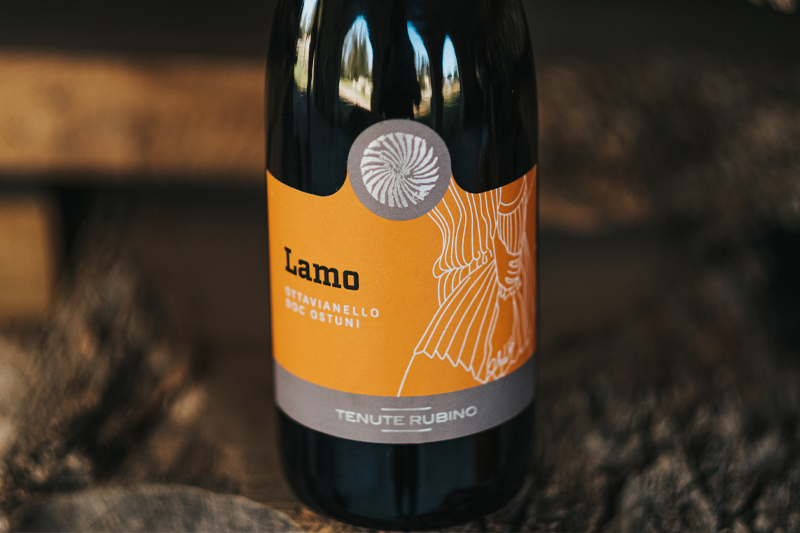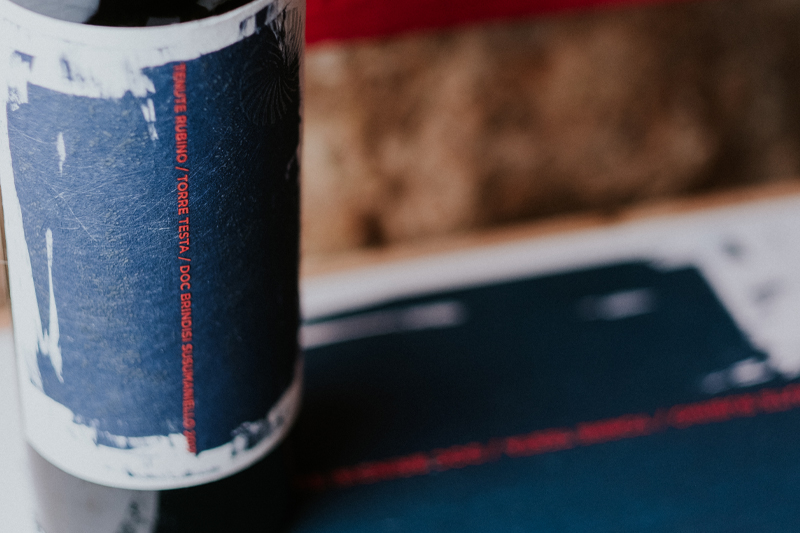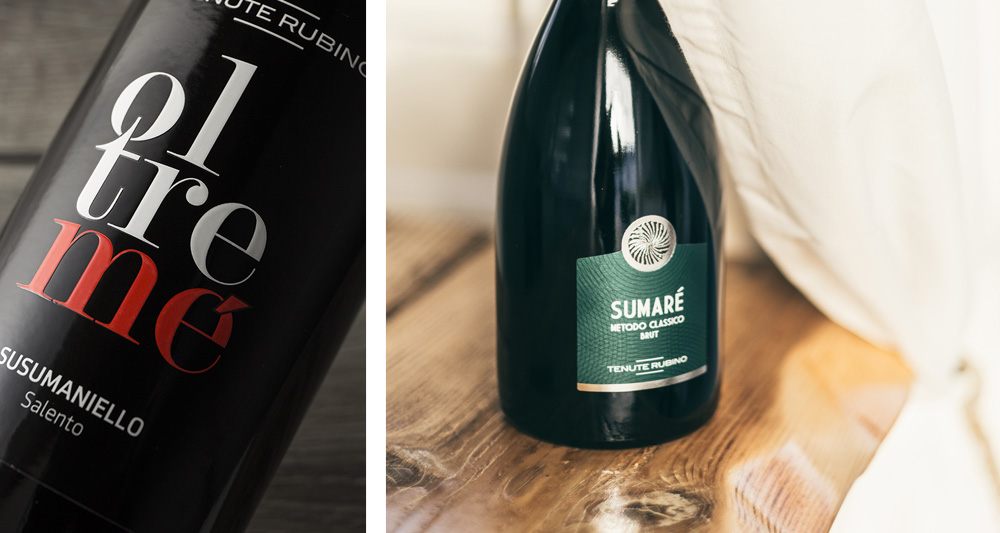-
Jaddico Estate
-
Uggìo-Punta Aquila Estate
-
The Ostuni vineyard
-
Palombara Estate
-
Padula di Geremia Estate
-
Torre Testa
-
Visellio
-
V’itra
-
Jaddico
-
Palombara
-
Oltremé
-
Miraglio
-
Punta Aquila
-
Lamo
-
Sumaré 27 months
-
Sumaré 60 months
-
Salende
-
Libens
-
Lamiro
-
Giancòla
-
Saturnino
-
Oltremé Rosato
-
Torre Testa Rosato
-
Aleatico
-
Aspettando San Martino
-
Cantine Aperte
-
La Vendemmia delle donne
-
RAP
-
Rubino Wine Party
-
Saturnino Wine Party
-
Tenute Rubino Wine & Friends
Ottavianello
Ottavianello: an expression of Apulian history which has resisted over time, like a standard bearer in the red lands of the Brindisi countryside, proud of its winemaking territory.
Name and history
Ottavianello is a special niche grape, mainly because its history and potential are still unknown. Its name originates from Ottaviano, an area in Naples province.
It’s from here that it was brought to Salento, to Brindisi, towards the end of the nineteenth century by the Marquise of Bugnano.
This variety’s journey probably began much earlier and further away in France, where it is known as Cinsault.
It is believed that the Marquise of Bugnano imported Ottavianello to Italy from the South of France.
Ottavianello is famous around the world for being a variety with great versatility and enormous potential. It is also found in South Africa where it is known as Hermitage, often used in the blend with Pinot Noir to create the famous Pinotage, or in France where it is called Cinsault, Ottavianello represents a true oenological treasure to be protected and preserved.

Varietal characteristics
Ottavianello is well-established in Salento and has become an integral part of the winemaking culture because of its perfect synergy with its surroundings, finding the ideal environment to best express its personality and quality.
In particular, its excellent predisposition to resist high temperatures and strong sunlight, helps this variety during the torrid Salentine summers and benefit from the mild winters.
Ottavianello grapes distinguish themselves for their ellipsoid shape and medium size, the violet skin with a heavy bloom.
Organoleptic characteristics
Wines produced from Ottavianello have organoleptic descriptors characterised by enjoyability and elegance.
Ottavianello is a grape that is naturally suited to ageing, and thanks to its versatile qualities, is never banal or monotonous.
The chromatic identity of Ottavaniello wines, the red wines are a deep ruby red full of intensity, overtime gradually becoming darker, the rosé wines on the other hand go from the lighter pink tones of the French rosès from Cinsault (Ottavaniello’s name in France), to the more intense Salento rosès.
The nose is characterised by clear notes of red fruits, enriched by floral notes of roses and violets, with a long trail of sweet spices with a herbal finish.
The impact of time on Ottavaniello’s bouquet is an evolution of the tertiary aromas.
On the palate it is extremely enjoyable, persistent and soft, with a velvety and elegant tannin.
Ampelographic Description
Bud Burst
At bud burst the bud has an expanded, velvety, little green apex with coppery hues. The apical and basal leaflets are velvety and light green in colour, the first are cupped and the second are folded. The bud’s axis is curved in shape.
Shoots:
The shoots are characterised by a circular cross section, a smooth and hairless outline and by their green colour with red highlights without lenticels
Tendrils:
The tendrils are long and thin, with a bifid form and light green in colour, with intermittent distribution.
Inflorescence:
The inflorescences are medium sized and have a simple and normal form with an elongated or pyramid shape.
Flower:
The flower is a hermaphrodite with a small sized, globular shaped flower bud.
Leaf:
The leaf is medium size with a five-lobed, pentagonal shape. The petiolar sinus has a U shape while the sides form a V shape or a closed lyre.
The flat lobes at the top of the terminal lobes are at right angles or acute.
The edge is flat or cupped, with a thick and smooth surface.
The upper leaf is bottle green, opaque and hairless, while the lower one is light green, with a bristly edge and with raised primary and secondary veins, bristly and green.
The teeth are pronounced, irregular and with convex margins over a wide base.
The petiole is green with pink grains, short, medium sized and hairless, without an obvious canal in the cross section.
Bunch:
The Ottavaniello bunch is medium sized, with a simple elongated or pyramid shape.
It’s length between 16-18 cm, the peduncle appears long, thin, woody and light green in colour.
Grape:
The grape is medium sized (13-15mm) and has a ellysoid-obovoid with a regular cross section and violet in colour. The skin is delicate and with bloom, the navel is persistent and prominent.
The pulp is juicy, consistent and sweet with colourless juice.
The pedicel is green and medium length, the pedicel is easily separated from the grape.
The end of the pedicel is green and isn’t evident, while the brush is pink and medium length. Depending on the vintage it can be subject to light millerandage.
Seeds:
The seeds are usually 2-3, medium sized, pyriform with a large beak.
Cane:
The cane is short, robust, flexible without branches, with a resistant bark and a circular or slightly ovale cross section; the surface is streaked with little bloom. It is a reddy-brown colour more evident in the internodes that are 5-8 cm long and equally distanced towards the flat knots.
The buds are pointed and the petiole is large and slightly protruding.
The diaphragm is flat – convex while the medulla is medium, the wood is soft to cut.
Trunk:
The vine’s trunk is fairly robust.
Phenology
Vegetative phenomenon
Germination occurs between the 10th and the 22nd April, which is followed by flowering between the 28th May and the 12th June. Véraison happens between the 28th July and the 13th August with a halt to shoot growth at the beginning of July. Grape maturation occurs during the 16th to the 30th September. The leaves fall in the last ten days of November.
Cultural aptitudes and characteristics
Vigor:
The vigor level is discreet.
Production: The production is good.
Positioning of the first bud: 2nd and 3rd knot.
Average number of inflorescences per bud: 2
Lateral shoots fertility: null
Multiple grafting development: normal
The Wines
Tenute Rubino continues the culture of Ottavianello through Lamo. Lamo expresses elegance and quality as a wine, through its characteristics it reflects the position of the Ottavianello vines in Ostuni, at an altitude of 218-380 metres above sea level, with a structured clay based soil. This type of terrain provides Lamo with a finesse, structure and intensity, with an important aromatic richness and a soft palate characterised by a delicate and balanced tannin.

